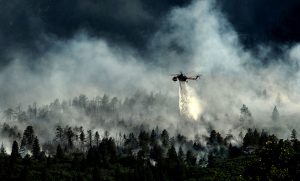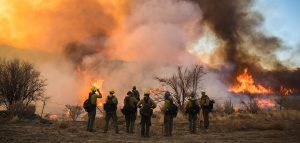10 September 2018
WASHINGTON D.C. — The number of deaths associated with the inhalation of wildfire smoke in the U.S. could double by the end of the century, according to new research.
A new study simulating the effects of wildfire smoke on human health finds continued increases in wildfire activity in the continental United States due to climate change could worsen air quality over the coming decades. The number of human deaths from chronic inhalation of wildfire smoke could increase to more than 40,000 per year by the end of the 21st century, up from around 15,000 per year today.

A helicopter drops water on the Waldo Canyon fire in Colorado Springs, Colorado, as firefighters continue to battle the blaze in 2012. Credit: U.S. Air Force photo/Master Sgt. Jeremy Lock
Wildfire smoke is composed of a mixture of gases and microscopic particles from burned material known as particulate matter. Particulate matter from wildfire smoke often reaches nearby communities and can irritate human eyes, exasperate respiratory systems and worsen chronic heart and lung diseases, according to the federal Centers for Disease Control and Prevention.
Exposure to particulate matter is associated with visibility degradation, premature death in people with heart or lung disease, heart attacks, irregular heartbeats, aggravated asthma, decreased lung function and increased respiratory symptoms, according to the U.S. Environmental Protection Agency. Older adults, children and those with heart or lung diseases are most at risk.
Researchers used global climate model simulations to estimate particulate matter’s impacts on air quality and human health in the contiguous United States in the early-, mid-, and late-21st century under different climate scenarios. The new study, published in GeoHealth, a journal of the American Geophysical Union, provides the first estimates of future smoke health and visibility impacts using a predictive land-fire model.

This image, captured by the NOAA-20 satellite’s VIIRS instrument on August 19, 2018, shows thick plumes of smoke over British Columbia. Credit: NOAA
Emissions of particulate matter from human activities—such as burning fossil fuels—are declining nationwide, but wildfires are increasing in frequency and intensity because of climate change, according to the study. From January to July 2018, NOAA recorded 37,718 fires that burned 4.8 million acres of land. In 2017, the U.S. Forest Service’s wildfire suppression costs reached a historic high of $2.4 billion.
The new study finds the number of deaths attributable to total particulate matter from all sources will decrease by the end of the 21st century, but the number of deaths attributable to fire-related particulate matter could double under the worst climate scenarios.
This new finding highlights the need to prepare for future air quality changes caused by wildfires in the U.S., according to the study’s authors.
“We know from our own research and many, many other groups that smoke has negative impacts on human health,” said Jeff Pierce, associate professor of atmospheric science at Colorado State University in Fort Collins and co-author of the new study. “With the knowledge that fires have been increasing in parts of the U.S., we wanted to look at how bad this might get.”
Looking Forward
In the new study, Pierce and his team analyzed the potential effects of wildfire smoke on human health over the coming decades. They simulated the impacts of changing fire emissions on air quality, visibility, and premature deaths in the middle to late 21st century under different climate scenarios.
They found that declines in particulate matter from human sources like car, industry and power plant emissions over the 21st century is offset by increases in smoke emissions from more intense wildfires, causing an increase in particulate matter in some regions. In the study, researchers used simulated concentrations of particulate matter generated by a model for early-, mid- and late-century time frames.
The new study predicts that average visibility due to particulate matter will improve across the contiguous United States over the 21st century, but fire-related particulate matter will reduce visibility on the worst days in the western and southeastern U.S. Haze from wildfire smoke affects how people see colors, forms and textures of a given vista or skyline. The fine particles in the air absorb and scatter sunlight, making it difficult to see clearly, according to the National Park Service.
From 2000 to 2010, approximately 140,000 deaths per year, or 5 percent of total deaths, were attributable to total particulate matter. Of those deaths, about 17,000, or 0.7 percent per year, were linked to particulate matter from wildfires. In the paper, the authors estimate uncertainties in these numbers.
The new study estimates fire-related particulate matter deaths could more than double by the end of the century in the worst-case-scenario prediction model.
“People could use this information as sort of a first estimate of what to prepare for in terms of future air quality,” Pierce said. “We need more simulations to be able to assess the different probabilities of what the future might be.”
Although there are increased efforts in place to reduce wildfire risks in the U.S., the occurrence of wildfires has continued to increase in frequency and intensity, which are strongly linked to a changing climate, according to the study.
To continue reducing the health burdens due to fire-related particulate matter, the study’s authors call for more emphasis on reducing exposure through public health campaigns in conjunction with climate mitigation efforts.
“I think that we need to act now,” said Sheryl Magzamen, associate professor of epidemiology at Colorado State University, who was not involved in the new study. “Our exposure to wildfire smoke is only going to get worse going into the next century, so we need to plan and be prepared in terms of acting to protect population health.”
###
The American Geophysical Union is dedicated to advancing the Earth and space sciences for the benefit of humanity through its scholarly publications, conferences, and outreach programs. AGU is a not-for-profit, professional, scientific organization representing 60,000 members in 137 countries. Join the conversation on Facebook, Twitter, YouTube, and our other social media channels.
*****
Notes for Journalists
This paper is open access. Journalists and public information officers (PIOs) can download a PDF copy of the article by clicking on this link:
https://agupubs.onlinelibrary.wiley.com/doi/full/10.1029/2018GH000144
Journalists and PIOs may also request a copy of the final paper and multimedia by emailing Kathryn Cawdrey at [email protected]. Please provide your name, the name of your publication, and your phone number.
Neither the paper nor this press release is under embargo.
“Future Fire Impacts on Smoke Concentrations, Visibility, and Health in the Contiguous United States”
Authors:
Bonne Ford, Emily Fischer and Jeff Pierce: Department of Atmospheric Science, Colorado State University, Fort Collins, CO.
Val Martin: Leverhulme Centre for Climate Change Mitigation, Department of Animal & Plant Science, University of Sheffield, Sheffield, UK.
Sarah Zelasky: Department of Environmental Sciences and Engineering, University of North Carolina at Chapel Hill, Chapel Hill, NC.
Susan Anenberg: Department of Environmental and Occupational Health, The George Washington University, Washington, D.C.
C.L. Heald: Department of Civil and Environmental Engineering, Massachusetts Institute of Technology, Cambridge, MA and Department of Earth, Atmospheric and Planetary Sciences, Massachusetts Institute of Technology, Cambridge, MA.
Contact information for the authors:
Jeff Pierce: [email protected], +1 (970) 491-8572
Bonne Ford: [email protected], +1 (970) 281-5563
Kathryn Cawdrey
+1 (202) 777-7437
[email protected]
